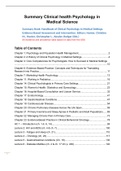Summary Clinical health Psychology in
Medical Science
Summary Book: Handbook of Clinical Psychology in Medical Settings.
Evidence-Based Assessment and Intervention. Editors: Hunter, Christine
M., Hunter, Christopher L., Kessler, Rodger (Eds.)
All incidence and prevalence rates based on data from the USA
Table of Contents
Chapter 1: Psychology and Population Health Management............................................2
Chapter 2: A History of Clinical Psychology in Medical Settings........................................4
Chapter 4: Core Competencies for Psychologists: How to Succeed in Medical Settings
..........................................................................................................................................10
Chapter 6: Evidence-Based Practice: Concepts and Techniques for Translating
Research into Practice......................................................................................................11
Chapter 7: Marketing Health Psychology.........................................................................13
Chapter 11: Working in Pediatrics....................................................................................16
Chapter 14: Clinical Psychologists in Primary Care Settings...........................................21
Chapter 15: Women’s Health: Obstetrics and Gynecology..............................................23
Chapter 16: Hospital-Based Consultation and Liaison Service.......................................32
Chapter 17: Endocrinology...............................................................................................41
Chapter 18: Gastrointestinal Conditions..........................................................................47
Chapter 19: Cardiovascular Disease................................................................................54
Chapter 20: Chronic Pulmonary diseases Across the Life Span.....................................59
Chapter 21: Primary Insomnia and Sleep Apnea in Pediatric and Adult Populations......69
Chapter 22: Managing Chronic Pain in Primary Care......................................................73
Chapter 23: Evidence-Based Practice in Clinical Behavioral Oncology..........................78
HC 1 – Introduction (ch. 1-4, 6, 14)..................................................................................94
Lecture 2: HIV and AIDS (ch. 4 & ch. 7).........................................................................100
Lecture 3 - Fatigue and sleep (ch. 21)............................................................................110
Lecture 4 – Oncology (ch, 23)........................................................................................117
Lecture 5 - Gastrointestinal conditions (Ch. 18).............................................................130
Lecture 6 - Diabetes Mellitus (ch. 4 & ch. 17 t/m p. 436)...............................................140
1
, Lecture 8 - Multiple Sclerosis and Parkinson’s disease.................................................160
Lecture 9 – Cardiology (Dounya Schoormans) (Ch. 19)................................................174
Lecture 10 - Lung diseases (ch. 20)...............................................................................185
Lecture 11 - Obstetrics and Gynecology (ch. 15)...........................................................198
Lecture 12 - Psychological treatment for disturbing somatic symptoms (ch. 3, 6, 14, 16)
........................................................................................................................................209
Exam examples..............................................................................................................227
Chapter 1: Psychology and Population Health Management
Population health management is an integrated approach to improve the health of an entire
population by targeting the systems and policies that affect health care quality, access and
outcomes.
Form a clinical psychology perspective --> clinical applications and interventions targeted at an
entire population.
Population health interventions are often integrated into the standard clinical settings, with
a shift in emphasis from individual patients with identified disorders/diseases to a larger
target population. E.g. routine screening of all patients for tobacco use in a family
medicine clinic, followed by a brief intervention or referral care.
Brief interventions can be:
o Provided by health care professionals, e.g.
psychologist as behavioural health consultant
o Technological approaches o Face-to-face
therapy Tobacco use, overweight and obesity,
and excessive alcohol use are the three
greatest contributors to mortality in America.
Population Health Management: An Overview
Classic example in history of the use of population health:
- John Snow discovered the source of the 1848 cholera epidemic in London.
He found that death due to cholera highly correlated with locations
surrounding certain water pumps. He theorized that cholera might be
spread through contaminated water supplies.
The modern-day population health emerged because the traditional approach of explaining and
treating illness on an individual level was too limiting.
Definitions of Population Health and Disease Management Population
health emerged from disease management.
Disease management = clinical interventions and approaches for individuals who have
already developed a specific disease. Others use a broader explanation for the term,
including the early interventions as well.
2
, Disease management consists of a group of coherent interventions designed to
prevent or manage one or more chronic conditions using a systematic,
multidisciplinary approach and potentially employing multiple treatment
modalities. The goal of disease management is to identify persons at risk for
one or more chronic conditions, to promote self-management by patients and to
address the illnesses or conditions with maximum clinical outcome,
effectiveness and efficiency regardless of treatment setting(s) or typical
reimbursement patterns.
Birkofer, L.. Handbook of Clinical Psychology in Medical Settings : Evidence-
Based Assessment and Intervention, edited by Christine M. Hunter, et al.,
Springer, 2014. ProQuest Ebook Central,
http://ebookcentral.proquest.com/lib/uvtilburg-ebooks/detail.action?
docID=1781925. Created from uvtilburg-ebooks on 2020-03-29 03:21:53.
Primary preventions = interventions such as prevention programmes.
Secondary preventions = interventions in an at-risk population
Tertiary preventions = interventions in populations already diagnosed with an illness to help
control symptoms and severity.
Ssurveillance includes methods to measure or assess the health status of a population.
E.g. review of electronic medical records to determine the prevalence of tobacco use or
obesity in specific population.
Cognitive-behavioral interventions at population level:
Passive:
- Adding fluoride to the water supplies --> everyone’s dental health
improved.
Four primary categories of environmental factors that can be modified to affect population
behavior:
1) Availability
2) Physical structures
3) Social structures and policies
4) Media and cultural messages
Tobacco Use o Problem:
In America tobacco is responsible for ± 1in 5 deaths. There is no safe level
of tobacco use so everyone who uses is target population for health
interventions.
o Population-level interventions:
Universal assessment and treatment in primary care settings.
Tailored self-help intervention through computer-based programs
3
, (however, mainly effective if person is already really motivated to quit). Telephone
counseling is another option. This one is particular effective as an adjacent interventions.
Often used in combination with self-help methods.
Weight Management o
Problem:
Number of people Being overweight and obesity is rising. Obesity is a major risk factor
for numerous chronic disease such as CVD, diabetes etc. o Interventions:
Most effective: multisession cognitive-behavioral treatments. Mostly done by face-to-face
counseling, but can also be done via technologies such as telephone and internet.
PDA = personal digital assistants who provide an outlet for self-monitoring of diet and
exercise behaviors.
Excess Alcohol Consumption o Problem: often referred to as problem drinking, heavy drinking
or at-risk drinking. Doesn’t have to be accompanied by alcohol dependence. Heavy drinking
= when you drink more than two standard drinks of alcohol per day (men) and more than
one (women). Excess alcohol consumption is associated with an increased risk of many
medical conditions such as cancer, pancreatitis, gastritis and cirrhosis as well as
neurological and cardiovascular problems. Alcohol is the third leading cause of death in
America.
Binge drinking = having five or more drinks at one sitting.
It costs a lot of money --> public; higher health care costs, private; higher costs due to
decreased productivity and higher insurance costs. However, there is a safe and healthy
level of alcohol consumption: Max of 2 drinks per day for men and 1 for women is
associated with reduced health risks and total mortality. o Interventions:
Most effective is intense individual treatment using either CBT or medication or a
combination of the two.
Largest randomized controlled trial was the Combined Pharmacotherapies and
behavioural Interventions (COMBINE) study.
However, such intensive CBT sessions are not available for everyone. Brief
interventions about one’s motivation have shown to be effective as well.
Web-based interventions are another approach such as the Screening and brief
Intervention (SBI). It includes assessment tool sin the screening phase, along with
assessment questions and personalized feedback in the intervention portion.
Drinker’s Check-Up (DCU) is another one: uses brief motivational interventions and can
be utilized as a separate intervention or as an introduction to alcohol treatment. Consists
of integrated assessment, feedback and decision-making modules. Uses the FRAME
approach.
Chapter 2: A History of Clinical Psychology in Medical Settings
Roots in History of Clinical Health Psychology
Formal start of Clinical Psychology in the 1890s by Lightner Witmer – also founder of the first
psychological clinic (mainly for children with speech problems, sleep disturbances and
behavioural problems).
4






